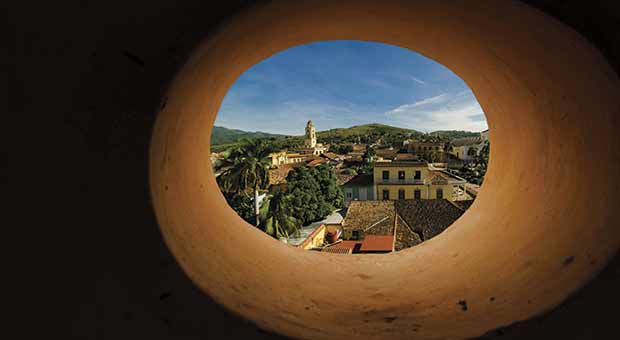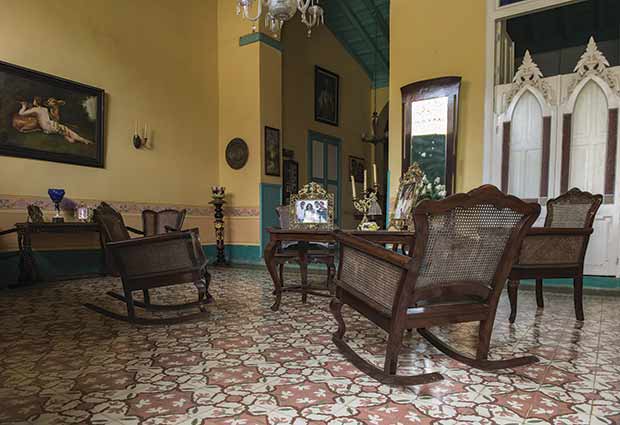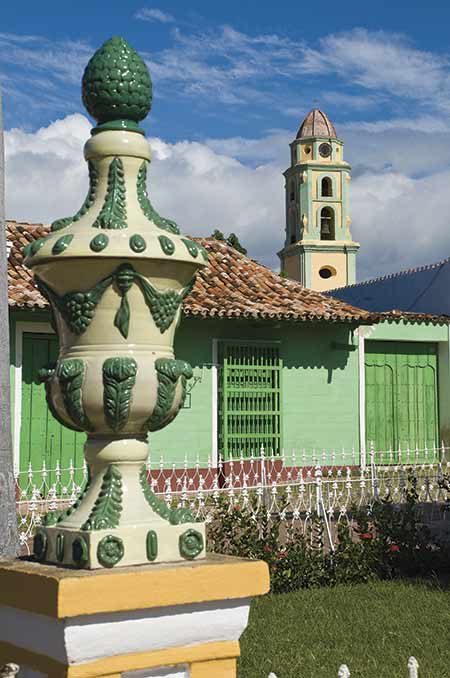Before its narrow cobblestone streets opened unabashedly to the world, even before the first lost strangers began to arrive, shouldering their rucksacks, the city of Trinidad was like an island within an island; its only channels of communication were by sea. Until public railway services were belatedly established in 1919 and roads were built to connect the city to Cienfuegos and Sancti Spíritus in the 1950s, Trinidad, the third Spanish colonial city built in Cuba, sleepily remained in the golden age of sugar.
With its 19th century features practically unaltered, the region has held a mystical fascination for decades. As folklorist Lydia Cabrera (1900-1991) used to say, beyond any archeological interest in its buildings, this was due more to “the persistence of the past, which lives on there in an intensely human way, not just in a single neighborhood, but meandering throughout its beautifully-named streets—Half Moon, White Lily, Disappointment—where autos seem ridiculous; not just in its peaceful little squares, but throughout the city, which speaks an old-fashioned language, and moves only to the rhythm of yesteryear. In Trinidad, the dead always have the floor.”
And that poetic memory has been held onto by successive generations of trinitarios, as the people of Trinidad are known. They are executors not only of a uniquely valuable architectural heritage, but also of an intangible legacy that, after half a millennium, has shaped the identity of these lands.
This peculiar symbiosis between the colonial city and its inhabitants is explained by Víctor Echenagusía Peña, a well-known expert with the Office of the Conservator of the City of Trinidad and the Valley of the Sugar Mills, and a fanatical champion of regional traditions: “It is a city that swathes you and protects you; it is not like others, where the buildings crush the individual. In Trinidad everything is comfortable—even the light is different. Surprises pop up constantly: you turn the corner and find an unexpected vision, but it is interrupted because the street twists and turns and leads to who knows where. And then afterward, you find the man playing dominoes on the corner, uninhibited, defying the heat. You can’t find anything like that in New York or London or anywhere else.”
Nowhere in Latin America and the Caribbean can you find place that has remained so well-preserved to this day, even down to the most insignificant detail: the doorknocker that announced the arrival of the Count of Casa Brunet; the stone tiles that were used as ballasts for ships and ended up covering the floors of the colonial town; the eaves with engraved corbels, the wooden railings, the delicately woven pieces …
It was with good reason that the UN Organization for Education, Science and Culture, at a meeting in Brasilia on Dec. 8, 1988, approved the inclusion of the Historic District of Trinidad and its Valley of the Sugar Mills (Valle de los Ingenios) on its list of World Heritage sites. It was recognition of the city’s value as an eminent example of “an architectural complex that illustrates a significant historical period” and of “a traditional human habitat, representative of a culture, and vulnerable to the effects of irreversible mutations.”
Well aware of the treasure that they inhabit, the people of Trinidad have been restoring, little by little—a wall today, a cornice tomorrow—the 2,052 buildings that belong to the Urban Historic District, divided into 50 blocks. They have also restored the distinction to the 276 square kilometers that encompass the so-called Valley of the Sugar Mills, where dozens of sugar mills and factories existed in the 19th century and which now is home to 73 archeological sites, the legacy of the sugar industry’s golden age.
However, it is not the opulence of yesteryear that most dazzles Cuban and foreign tourists alike, but the possibility of discovering streets and buildings of immeasurable value, and in fact a whole city of patrimony, centuries-old but unquestionably alive, a city whose inhabitants adapt, unperturbedly, to the postmodern age and the cosmopolitan airs of this urban center.
“Trinidad has left me disconcerted,” confesses Ana Teresa Guzmán, a woman from Madrid who was visiting the city amid preparations to celebrate its 500th anniversary. “I’ve been to Cartagena de Indias, Guayaquil and other colonial cities in Latin America, but here everything seems magical. It is as if you were entering a parallel universe; it is the most
spectacular place I have ever seen.”
It is an opinion shared by many, from the travelers who roam through its ancient streets every day to the most prestigious experts: the Historic District of the City of Trinidad and its Valley of the Sugar Mills are disconcerting, moving. That sensation is the argument brandished by specialists to demonstrate that with the minimalism of an inhabited city, without monumental cathedrals or imposing military fortresses, it is also possible to conquer half the world.













